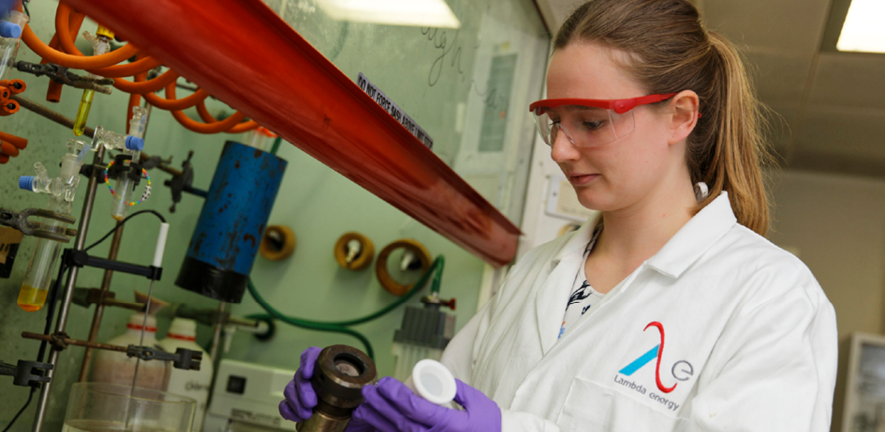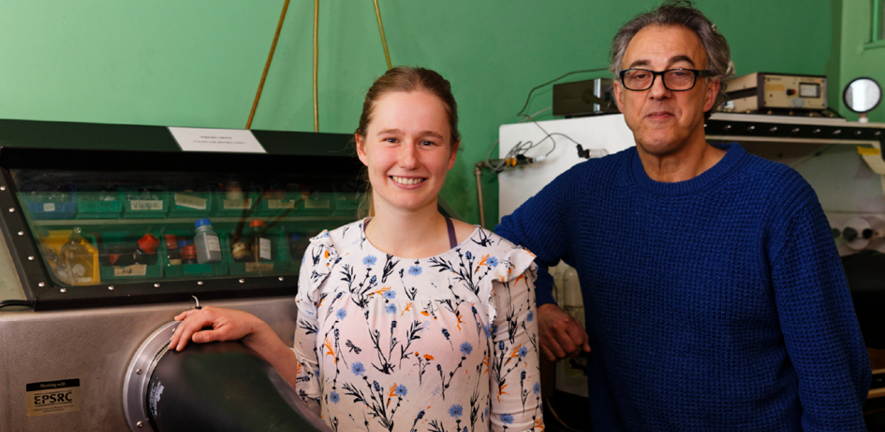
As a student in Professor of Inorganic Chemistry Dominic Wright’s research group, Rosa is playing a key role in the development of new nanomaterials which can be used to enhance solar absorption in plants and solar cells.
The problem
Plants grow in sunlight, but crop plants are much more productive if exposed to higher amounts of the lower-energy wavelengths of the solar spectrum, such as red.
The Wright group is creating molecules which are able to ‘down convert’ the high-energy photons in sunlight to more plant-friendly wavelengths. The group is working in collaboration with an R & D start-up called Lambda Energy.
“Too much UV light is damaging for plants, so high-energy or blue-end light is not used efficiently for plant growth,” explains Dr Boris Breiner, Lambda’s Chief Scientist. “But if you can down convert the light to the optimum wavelength for plant growth, for example inside a greenhouse, you can increase crop yields without spending more on artificial lighting.”
The science
Simply put, Rosa’s job is to make new molecules. The more effective the molecules are at converting the high wavelengths to the visible spectrum, the greater the quantum yield.
Rosa describes the molecules she synthesises as ‘chunky’. They are structured as molecular cages that include the lanthanide Europium, which is known to absorb UV light and emit red light. Rosa says: “We started with a very easy form of these compounds, and then you test them and learn which aspects you can improve.”
The researchers use X-ray crystallography to confirm the characteristics of the new molecules, which are then tested for quantum yield. The most promising are scaled up by Dr Petra Cameron’s group at the University of Bath and incorporated into polymer films by Lambda Energy before being tested once again.
“We based our initial studies on molecules which were reported to have quantum yields varying from 40 to 50 percent, but thanks to Rosa’s molecules, we’ve now got a material with almost 100 percent quantum yield,” explains Boris.
The new materials can also be used to improve the efficiency of the photovoltaic cells used in solar panels. These cells work best at converting red and near infrared light into electricity and are much less effective at converting UV and violet light. Lambda’s new coatings could down convert these higher-energy wavelengths to red light, thereby increasing electrical output. Lambda has recently filed a patent to protect this new technology.
Next steps

Rosa Mueller and Dominic Wright, Nathan Pitt, ©University of Cambridge.
The next challenge will be to increase the range of high energy photons that can be absorbed before being down converted. Rosa says: “If you look at the solar spectrum, there is not that much UV light, because it’s absorbed by the atmosphere. So we are also trying to capture the photons in the blue and the green range. It is currently very tricky.”
Boris agrees: “UV light is only three to five percent of the solar spectrum, but we want to capture 20 percent, so we need to shift absorption into the blue end of light. That is what we are working on now.”
The team members are upbeat about the future, and are looking forward to testing their new nanomaterials in a series of greenhouse experiments at Cranfield University this summer.
“We are developing new materials that are cheap, robust and with a very high quantum yield,” says Boris. “They will not only improve crop yields in greenhouses, but they also have great potential for improving solar cell efficiency. They also have other uses in medical sensors, display technology, and anti-counterfeiting technology in money.”
The scientist
Dom says: “This is a story of how a PhD student has basically built the molecular side of the project. Rosa’s been the primary one delivering on the new materials and making the molecular chemistry actually work.”
Boris agrees. “We give her minimal input. For example we come to her and say ‘can you try this?’ and it turns out she’s already thought of that!”
In the little free time that she has, Rosa, who is a member of St John’s College, loves to row. “I love Cambridge,” she says. “Partially because I do so much rowing, but also it’s been really easy to find a social environment that I like. And all the members of our group are really great.”
But Rosa also enjoys making molecules, and Dom and Boris both agree that she is especially skilled in her role. “She’s not just good,” says Boris. “She’s good good.”
This article first appeared in Chem@Cam Issue 66. You can find the magazine online here.

